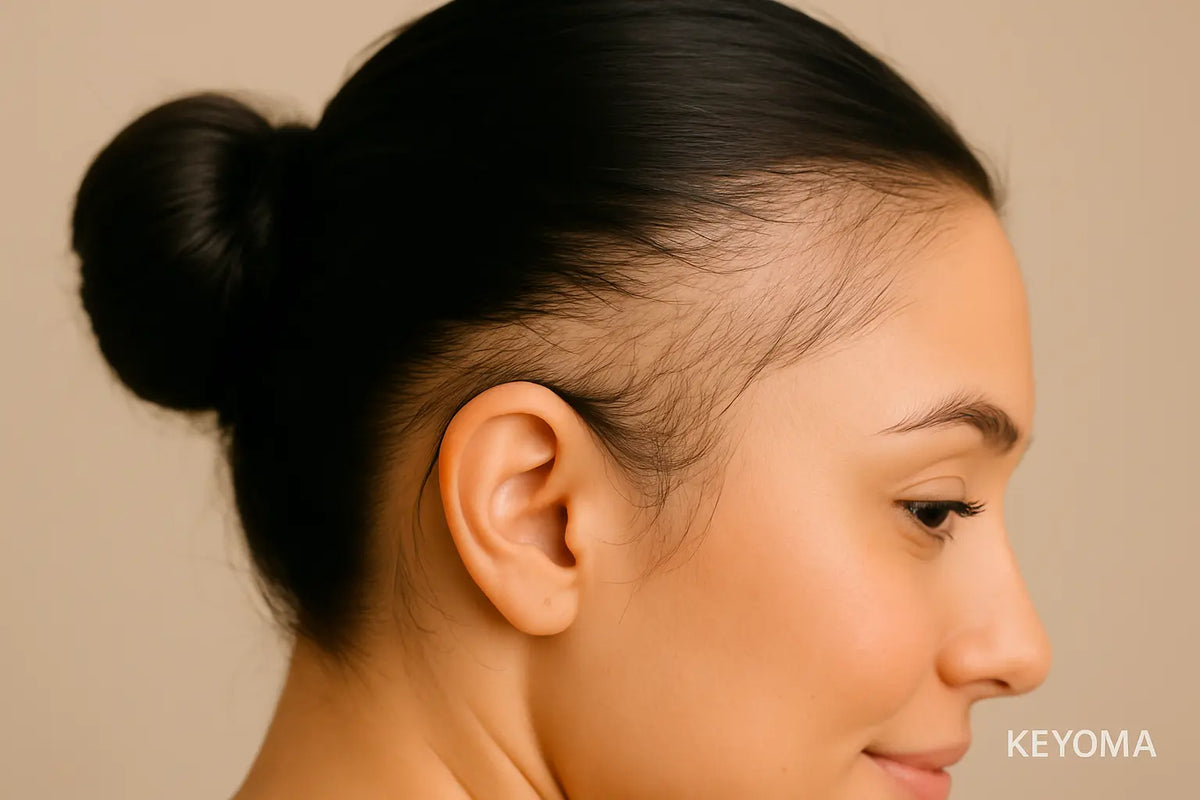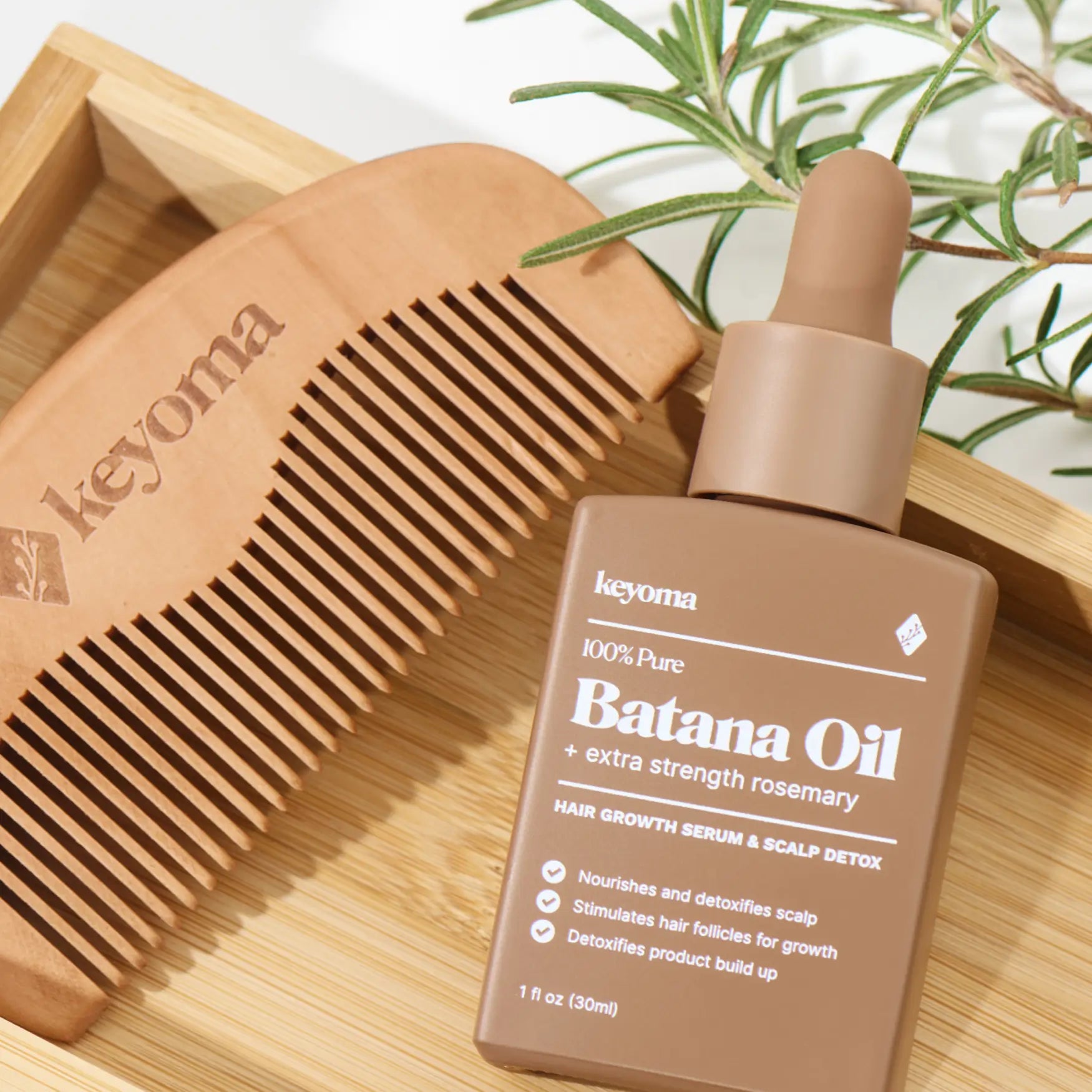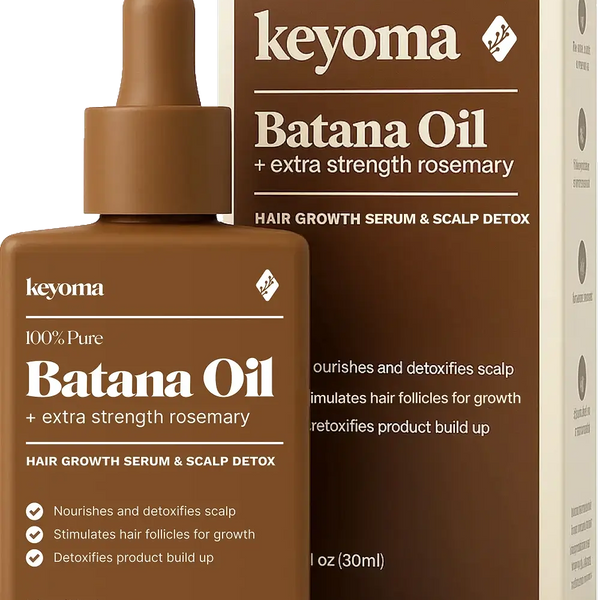In this article
That thinning around your edges or those sore, tender spots near your ponytail might not just be a bad hair day. It could be something deeper: traction alopecia.
It’s a type of hair loss that develops quietly over time, especially if you love sleek buns, braids, or tight styles. That’s often why it feels like your hair started thinning “suddenly,” even though the tension’s been building for a while.
The good news is that traction alopecia can be stopped—and in many cases, reversed.
In this article, we’ll talk about what it really is, which hairstyles cause it, the early signs you should never ignore, and the simplest ways to treat it naturally before it becomes permanent.
Key Takeaways
-
Traction alopecia happens when repeated tension on your hair, often from using tight braids, ponytails, or extensions, causing gradual thinning around your edges.
-
The best fix starts with loosening your styles, keeping your scalp clean, and using nourishing oils like batana, rosemary, or jojoba to calm irritation and strengthen fragile roots.
-
Long-term recovery also depends on healthy habits like eating a nutrient-rich diet, managing stress, and getting enough sleep.
What Is Traction Alopecia?
Traction alopecia is a type of hair loss caused by repeated tension on the hair roots, most often from tight hairstyles like braids, ponytails, or buns.
When hair is pulled too tightly for long periods, that constant strain inflames and weakens the follicles. The root becomes damaged over time, leading to thinning or balding around the hairline and temples. If the tension keeps up, it can even result in permanent scarring.
That said, traction alopecia is, in many cases, reversible, but only if you remove the stress that’s causing it before the follicles are scarred for good.
Causes of Traction Alopecia
Traction alopecia can be caused by any hairstyle or habit that puts constant, repetitive strain on your hair roots. The most common triggers include:
-
Tight hairstyles: High ponytails, cornrows, tight braids, locs, and sleek buns pull on the same sections of hair again and again. People who wear these styles daily—like ballerinas, athletes, or those in uniformed professions such as the military—are the most at risk.
-
Hair extensions or weaves: The added weight of extensions can tug on natural strands, especially near the hairline or crown. Over time, this traction creates localized bald patches.
-
Headgear and accessories: Helmets, headbands, or religious coverings worn tightly can rub against the scalp, causing friction and breakage around the edges.
-
Chemical and heat styling: Straighteners, relaxers, and harsh dyes don't cause traction alopecia directly but they can weaken strands already under tension, which speeds up follicle damage.
Early Warning Signs of Traction Alopecia
Traction alopecia develops gradually and often goes unnoticed behind the hairstyles we wear every day. Many only realize something’s wrong once the thinning becomes visible.
Below are early traction alopecia symptoms worth paying attention to so you can catch the problem before the damage becomes harder to reverse:
-
Tenderness or soreness: Your scalp feels sore, tight, or bruised after undoing a tight bun or ponytail. That pain is your follicles protesting the constant pull.
-
Flaking or redness: Irritated skin, tiny flakes, or redness along your hairline can signal inflammation from tension or friction.
-
Pimple‑like bumps: Small raised spots may appear where follicles are inflamed or infected. Dermatologists call this traction folliculitis, and it’s an early warning that you’re overstraining your roots.
-
Thinning at the hairline or part: Hair starts looking sparse in areas under the most tension—usually temples, crown, behind the ears, or nape. Sometimes breakage happens before you even notice shedding.
Compared with other hair loss types such as androgenetic alopecia or alopecia areata, traction alopecia usually shows patchy thinning in areas under tension rather than diffuse hair loss, which spreads more evenly across the scalp.
And another thing. One symptom usually comes with another. For example, you might notice mild soreness or redness before you start seeing visible thinning, or flaking that appears alongside small bumps where the follicles are irritated.
Traction Alopecia Treatments
Reversing traction alopecia starts with giving your follicles a rest and creating a healthier scalp environment. Here are specific treatments to help you with traction alopecia reversal:
Let Your Scalp Rest
Naturally, the very first step is to go straight to the root of the problem—stop wearing those high-tension hairstyles. Let your hair fall free and give your scalp a breather. This simple change allows any inflamed follicles time to heal and start producing new hairs again.
Massage Your Scalp Daily
When traction alopecia keeps certain scalp areas tense, the constant pulling limits blood flow and starves follicles of oxygen and nutrients.
Fortunately, daily scalp massages help loosen those tight spots and bring circulation back, reviving weakened follicles in the process.
To do it, use your fingertips to make slow, circular motions for 3–5 minutes each day. For an extra boost, pair your massages with plant-based nourishing oils or natural extracts.
And speaking of hair oil...
Apply a Nourishing Hair Oil
When traction alopecia strains and inflames follicles, the outer scalp barrier weakens and loses its natural oils, leaving the area dry, tender, and prone to further breakage.
That’s why replenishing those lost lipids with nourishing oils makes sense.
Hydration and nutrition are essential for follicle repair, helping restore comfort and protection where tension caused micro‑damage.
Some of the oils that have been heavily studied—and that I can personally vouch for having used myself—are the following:
-
Batana oil: Known for its rich lipid profile and tocotrienols, batana oil nourishes weakened follicles and keeps hair supple and healthy-looking.
-
Rosemary oil: Backed by clinical studies comparing it to 2% minoxidil, rosemary oil helps wake up sluggish follicles and encourage new growth in areas where hair’s been pulled thin.
-
Coconut oil: The classic hair conditioning oil that penetrates deeply into the hair shaft, reducing protein loss and strengthening fragile strands against breakage.
-
Peppermint oil: Cooling and vasodilating, it "wakes up" dormant follicles while providing a soothing tingle that promotes relaxation and comfort.
-
Jojoba oil: Closest in composition to natural sebum, it balances moisture levels and rebuilds the scalp barrier without leaving a greasy feel.
Use Clinically Tested Medications
While natural options can support recovery, lab‑tested drugs remain some of the most studied and effective treatments for stimulating new growth and preventing further loss.
Here’s what’s commonly used for traction alopecia, especially when thinning is advanced:
-
Minoxidil: This topical solution helps extend the growth phase of the hair cycle and improve blood flow to the scalp. It's available in 2% and 5% strengths and often used once or twice daily.
-
Finasteride: A prescription oral medication that blocks the conversion of testosterone to DHT, a hormone linked to follicle shrinkage. It’s mainly used in men but may be prescribed off‑label for women in specific cases under medical supervision.
-
Ribociclib: Ribociclib has shown early potential in studies for stimulating dormant follicles and reducing inflammation around the scalp. It’s still being investigated and should only be considered under guidance from a dermatologist or clinical specialist.
Always consult a board‑certified dermatologist or trichologist before starting any drug‑based regimen, especially if you’re already using natural oils or topical treatments.
Use Low‑Tension Protective Styles
Protective styles are absolutely still possible—you just have to keep them loose. Braids, twists, or buns done with minimal pull are much safer for your scalp.
A quick way to tell if your style is gentle enough is to notice how it feels when you move your head or lie down. If there’s any discomfort, it’s too tight. Untie and do it properly this time.
And while the style’s in, don’t forget to cleanse your scalp gently to prevent buildup that can clog follicles and slow regrowth.
Improve Nutrition and Lifestyle
So far, everything we’ve talked about has focused on what you can do to your hair, like changing your hairstyle, using oils, or massaging your scalp. And of course, those are all important.
But one thing we often forget is that healthy regrowth also depends on what’s happening inside your body. I’ve talked about this before in my article on holistic hair growth, where I explained the five key pillars—with nutrition and lifestyle being two of them.
On one hand, good nutrition fuels your follicles with essential nutrients like protein, iron, zinc, omega-3s, and vitamins D and B-complex, all of which help your hair grow stronger and more resilient.
On the other hand, lifestyle plays its part too. Getting enough quality sleep helps lower cortisol (your stress hormone), and that allows follicles to stay active longer.
These small habits might not show results overnight, but they work quietly in the background, creating the kind of internal balance that external care alone could never match.
See a Dermatologist or Trichologist Early
If you’ve been treating traction alopecia at home for several months with little to no improvement, it’s time to see a professional. Doing so can help prevent scarring and improve your chances of full recovery.
Dermatologists or trichologists may recommend topical minoxidil, anti-inflammatory treatments, or low-level laser therapy if inflammation persists.
Common Mistakes When Treating Traction Alopecia: The Don'ts
Sometimes the problem isn’t what we do right but what we unknowingly keep doing wrong. If your goal is traction alopecia reversal, here are the common pitfalls to avoid so you don’t undo your progress:
-
Don't restyle too soon: Even if your hairline starts showing baby hairs again, resist the urge to go back to tight braids or slick ponytails right away. The follicles are still fragile and need more time to rebuild strength.
-
Don't scratch or pick the scalp: It may relieve the itch for a moment, but it also disrupts healing and can cause small infections that slow regrowth.
-
Don't overuse products: Layering too many oils, serums, or sprays clogs follicles and traps sweat, which can worsen inflammation. Stick to a simple routine that lets your scalp breathe. https://keyomahealth.com/blogs/hair-care/hair-oiling-tips
-
Don't skip hair wash days: Dirt, oil, and buildup can suffocate follicles and stall recovery. Gentle cleansing is part of traction alopecia treatment at home. It keeps the scalp clean and ready to heal.
-
Don't use harsh chemicals or heat too soon: Relaxers, dyes, and high‑heat styling tools weaken new growth. Wait until your scalp is calm and baby hairs have thickened before reintroducing them.
-
Don't ignore persistent pain or bumps: Ongoing tenderness or traction folliculitis means the problem isn’t fully resolved. See a dermatologist or trichologist for professional guidance.
-
Don't use elastic bands when tying your hair: Go for satin or silk scrunchies as they're softer and gentler to your hair.
Frequently Asked Questions
Is traction alopecia permanent?
Traction alopecia isn’t always permanent, but it can become so if the pulling continues long enough to scar the follicles. The longer the tension and inflammation last, the higher the chance that the roots stop producing new hair altogether.
Can traction alopecia be reversed?
Yes, traction alopecia can often be reversed if the follicles haven’t been scarred yet. The key is to stop the pulling early and give your scalp time to recover.
Holistic hair growth habits like eating well, getting quality sleep, and doing regular scalp massages—with consistency—help a lot in supporting regrowth and restoring balance to the scalp.
Which hairstyles are safest while healing from traction alopecia?
Soft buns, loose braids, twists, and low ponytails—or simply letting your hair fall freely—are gentle styles that don’t pull too much on the scalp.
Generally speaking, you can stick with any hairstyle as long as it doesn’t feel tight or cause soreness when you move your head or touch your roots.
What ingredients help with traction alopecia?
Ingredients like rosemary, peppermint, jojoba, and batana oil help improve scalp circulation while deeply conditioning the skin and follicles. You can also look for products containing peptides, caffeine, or melittin (from bee venom), which support stronger regrowth and help revive weakened follicles.
Let Your Scalp Heal, and Your Hair Flow Freely
Wrapping up, traction alopecia usually starts small, with mild tenderness or thinning at the edges, but it can progress if you don’t ease the tension soon enough.
The good news is that small, consistent changes go a long way. Looser hairstyles, gentle scalp care, and a bit of patience can help your follicles recover over time.
Personally, I’ve made it part of my weekly routine to plan balanced meals rich in protein, iron, and healthy fats. I also do regular scalp massages, usually before heading out, with my tried‑and‑true rosemary‑infused batana oil. It’s a simple ritual, but one that’s kept my hair soft, hydrated, and healthy for years.
If you want more practical tips, ingredient insights, and routines like this, head over to the Keyoma Blog. You’ll find free, in‑depth guides on holistic hair care and scalp health to help you keep your strands strong for the long run.
Featured Product
100% Pure Batana Oil + Rosemary









